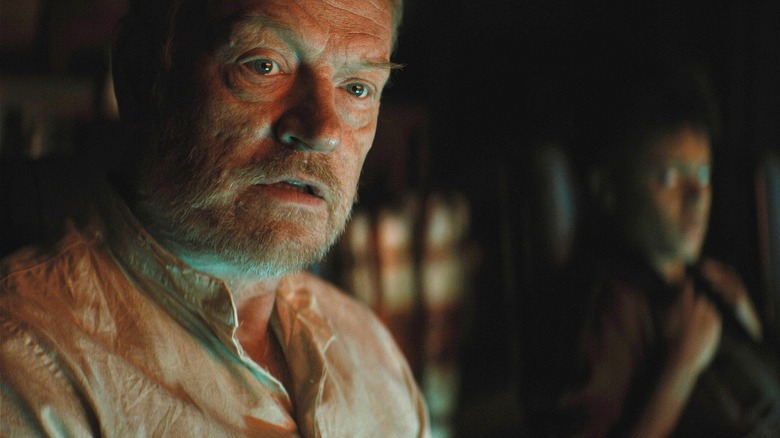Foundation Season 2: What Is A 'Seldon Crisis' And How Will It Impact Season 2?
Contains spoilers for "Foundation" Season 2, Episode 1
Isaac Asimov's sci-fi universe is full of robots, empires ... and crises. Robotics is flashy, and Empire is fun to look at, but Seldon crises are arguably one of the most interesting things that the author ever created. They're predictable, yet fascinating ... in a weird kind of way.
For a little context, "Foundation" centers on a scrappy group of humans who set up a colony called the Foundation on the edge of the galaxy 20,000 years in the future. They believe they're exiles, tasked with the job of recording an "Encyclopedia Galactica" (an epic accounting of all there is to know about the hundreds of millions of planets and systems within the Empire).
But this is a ruse. They're actually meant to preserve not just information but civilization itself.
The decaying Empire is on a Roman Empire-esque decline into chaos. Eminent mathematician Hari Seldon (Jared Harris) sees the writing on the wall and creates the mathematical field of Psychohistory in order to predict the future from a 10,000-foot view. He uses his math to set the Foundation on a trajectory to replace the crumbling Empire within a mere 1,000 years, avoiding 30,000 years of Dark Age chaos in the process.
Psychohistory is a powerful tool, and one of its most important elements, at least early in "Foundation," are "crises," which come to bear the title of Seldon himself, aka a "Seldon Crisis." These are "turning point" moments in the future, where psychohistoric math predicts a challenge will arise with no alternative options. The Foundation is given a mathematical chance of success or failure against that challenge, and if they survive, they continue on their pre-ordained mathematical trajectory until they hit the next crisis.
How badly does the Foundation deviate from Seldon's Plan in the show?
In the first episode of Season 2 of Apple's "Foundation," mathematician Gaal Dornick (Lou Llobell) uses an essential psychohistory device called the Prime Radiant (the physical MacGuffin of the series to psychohistory's metaphorical one) to help with a little fast-paced exposition. She shows Salvor Hardin (Leah Harvey) that in the first crisis at the end of Season 1, the Foundation veered way off course. Even worse, as a consequence, it is about to face a string of increasingly common crises if they don't get it back on track.
Dornick adds that she was supposed to be there to help solve the first crisis, but she wasn't. Hardin's fortunate presence was the only thing that kept the whole thing vaguely on course. Even so, she makes it clear humanity is currently on a new path, one Hari Seldon didn't account for with his mathematics.
In essence, Dornick is saying that if they don't figure out how to correct things to get back in sync with the psychohistory predictions, the dreaded Dark Ages they fear will happen. This sets the stakes for the season, even as the Prime Radiant reveals another, even bigger crisis about to unfold. The episode ends with Dornick, Hardin, and the suddenly resurrected digital ghost of Seldon himself clearly positioned to try to help get things back on track. As a way to drive the story forward, this works fine. It creates a literal crisis out of a Seldon crisis and leaves the protagonists to fix it or fail. The interesting thing is, this isn't what a Seldon Crisis looks like in the books, especially this early in the history of the Foundation.
Seldon crises, according to the source material
In Asimov's books, a crisis represents not so much a negative deviation from Seldon's Plan so much as a crossroads or a turning point. You could almost call it a pass-or-fail test; if the Foundation passes the crisis, it continues on its course. If it fails, it deviates. So a deviation is possible, it just isn't automatic. Where the show has thrown a monkey wrench into things is with the fact that Salvor Hardin saved the day in Season 1's crisis ... and they still went off course.
In the book "Foundation" (the first in the primary trilogy), Seldon appears out of the Vault (the fancy diamond-shaped floating container on Terminus in the show) multiple times. Rather than the four-dimensional, practically sentient digital-copy-of-a-character in the adaptation, though, Seldon in the books is merely a pre-recorded hologram. He appears more than once — even within the first book — decades apart at pre-determined times. When he shows up, Seldon updates his Foundation about the crises that they're about to or have just faced.
After the second crisis (which the show lumps in with the first crisis in Season 1), Seldon explains that he doubts they've failed to stay on course up to that point. "For my figures show a ninety-eight point four percent probability that there is to be no significant deviation from the Plan in the first eighty years," he explains.
In other words, if they've passed the first pair of crises, they're still on course. In Season 1, the Foundation does survive those incidents, but by the opening of Season 2, they're treating the success like a failure. It's an interesting twist, but one that makes some head-scratching alterations to the entire "crisis" concept.
A crisis domino effect that never ends?
The fact that a crisis can have such catastrophic consequences, even when it kind of didn't really fail, is a subtle but game-changing adjustment to Asimov's concept.
It's not that crises never go wrong. Later in the book series, the Foundation does fail certain crises and veers off course accordingly. To do so this early in the story, though, undermines the sense of inevitable initial forward momentum psychohistory has in the books. It gives the idea that a crisis is a failure in the plan rather than a foreseen crossroads with a mathematical probability of success. It is presented as more of a flaw in the system than anything else.
The kicker is, in the scene in Episode 1 where Dornick outlines the necessity of getting back on track, she clarifies that failing to do so could lead to an infinite number of crises. This could extend the "Dark Ages" that they all fear, with the mathematician suggesting the cycle of failure could perpetuate forever.
This is a dramatic extrapolation. Even in the books, the worst fear is that a 30,000-year Dark Age will have to play out before civilization resets, not an eternal cycle of chaos. The goal of the Foundation in Asimov's writings is to shorten that cycle. In the show, the stakes have been dramatically raised to a "we fix this or humanity may be lost forever" level. One could almost say that this shifts the "yes or no" success rate concept of individual crises and applies it to the larger purpose of the Foundation as a whole. It'll be interesting to see where it all goes in the end. For now, it looks like it's time to buckle up for a wild ride.



